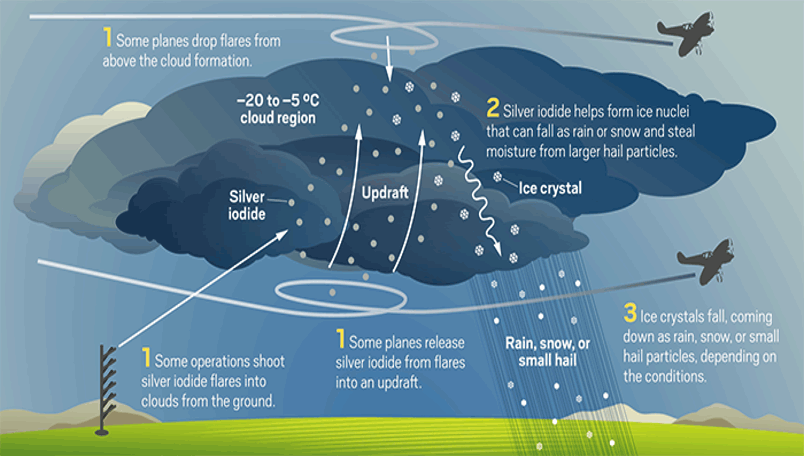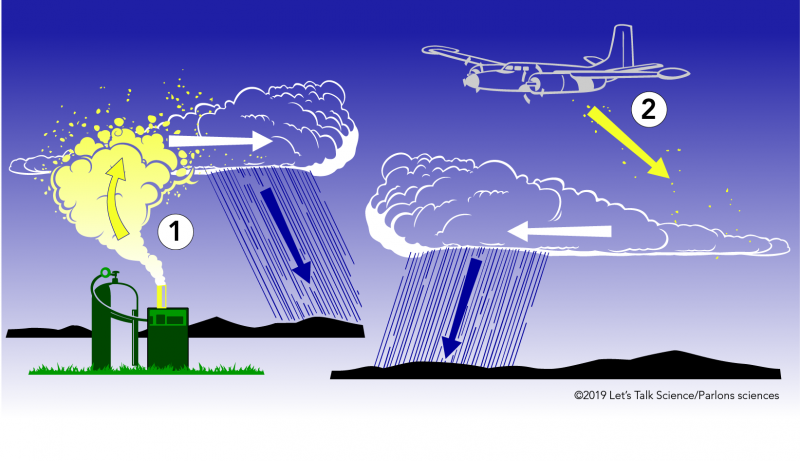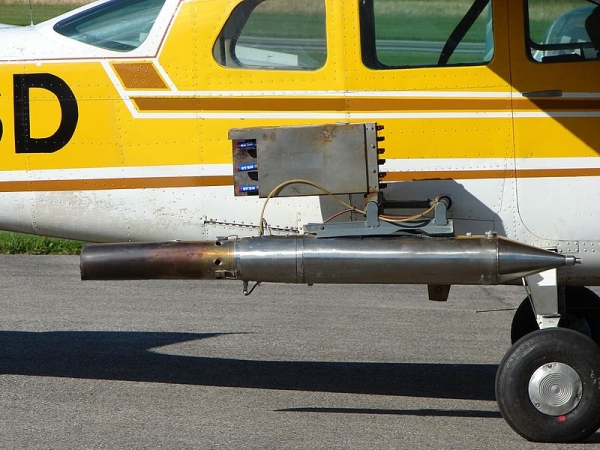What is Cloud Seeding?
Cloud seeding is a type of weather modification. Learn about cloud seeding, as well as its risks and benefits.
When you got up this morning, you probably wondered what the weather would be like. Any rain in the forecast? Fog? Maybe snow? Any storm warnings? People have always tried to predict the weather so they can prepare for it. After all, we have no control over the weather. Or do we?
Cloud physicists study weather modification. They have found ways to tweak the weather. Let’s look at a weather modification technology called cloud seeding.
What Is a Cloud?
Clouds are made up of tiny water droplets called cloud droplets. Groups of cloud droplets form water vapour (gas) or ice crystals.
Water vapour isn’t dense enough to fall to the ground as precipitation. Instead, it rises into the sky and becomes supercooled. Eventually, it condenses (turns to a liquid) around tiny particles of dust in the sky. These tiny particles are called condensation nuclei. It takes billions of these condensed water droplets to form a visible cloud.
What Is Cloud Seeding?
Clouds carry water. Unfortunately, that water doesn’t always get to where it’s needed on the ground.
When the water molecules are spread out, they aren’t dense enough to feel Earth’s gravity. When the molecules huddle together, they form larger, heavier droplets. Eventually, they become heavy enough to fall to the ground as precipitation.
Cloud seeding involves modifying a cloud’s structure to increase the chance of precipitation. Cloud seeding adds small, ice-like particles to clouds. Usually, silver iodide particles are used.
These particles act as additional condensation nuclei. Unattached supercooled water vapour molecules in the clouds condense around these particles. Then, the condensed water vapour droplets group together. This process continues until the droplets are large enough to fall as rain!
There are two ways of adding particles to clouds:
- Using large cannons that shoot particles into the sky
- Using airplanes that drop the particles from above
Why Use Cloud Seeding?
There are a lot of reasons to use cloud seeding. Ski resorts use it to increase snowfall. Hydroelectric companies do too, because more snow means more runoff in the spring. And more runoff means more water for electricity.
Cloud seeding can also clear away fog by turning it into precipitation. This can help improve visibility around airports.
In Alberta, cloud seeding is used to manage hail. It increases the number of ice pellets in hail-producing clouds. But it also decreases the size of each pellet. This reduces the damage caused by hail.
Are you wondering whether cloud seeding can be used to fight drought? Or forest fires, like the one that devastated Fort McMurray in 2016? Not necessarily. Cloud seeding can’t create clouds. It can only add particles to clouds. These particles interact with the water vapour already present in the air.
But China, Russia, and Thailand have successfully put out forest fires with cloud seeding. Scientists in Australia have also suggested using cloud seeding to get more water from clouds when it does rain, then saving that water for times of drought.
What Are the Potential Dangers of Cloud Seeding?
Cloud seeding has many uses. It’s been around for a long time. But not everyone is convinced it’s a good idea. Why?
There is evidence that cloud seeding works. It can create a 10-15% increase in rainfall. But some argue that this benefit doesn’t outweigh the risks to public safety and the environment.
Silver iodide, the material used in cloud seeding, is toxic to aquatic life. So precipitation from seeded clouds can harm the environment.
In response to these concerns, scientists have tested nontoxic replacements for silver iodide. They have found calcium chloride to be effective. Low doses of this salt are unlikely to harm the environment. Cloud physicists are also researching the possibility of using negatively charged ions instead of ice-like crystals.
Did you know?
At the 2008 Olympics in Beijing, cloud seeding was used to ward off rain during the opening ceremonies.
But there are other potential risks to increasing precipitation in a specific area. Will rain in one area bring drought to another? Could cloud seeding cause too much rain to fall? Can it cause flooding? Scientists don’t know all the answers. After all, weather systems are very complex. It’s impossible to predict exactly how weather modification efforts will play out.
So far, no droughts have been blamed on cloud seeding. In fact, surrounding areas tend to get more rather than less rain. In 1972, a flash flood devastated Rapid City, South Dakota. People there suspected that nearby cloud seeding operations might have been a factor. There is no proof that cloud seeding was to blame. Still, events like this one are bound to make people skeptical.
Weather modification techniques have also been used as weapons. For example, during the Vietnam War, the United States ran Operation Popeye. It used weather modification technology to extend the monsoon season in Vietnam. This flooded the roads and rivers that enemy troops normally used. In 1977, an international treaty banned the use of weather modification for military and other hostile purposes.
Did you know?
Cloud seeding is just one of many technologies used to control the weather. Together, these technologies form the field of geoengineering. It focuses on fighting climate change.
Summing Up…
Some governments are staunch supporters of weather modification technology. China and Russia are two of these countries. But in North America, cloud seeding doesn’t receive government funding. It’s still too controversial. That hasn’t kept private companies from using it, though. For example, we talked about how cloud seeding is used to reduce hail in Alberta. A lot of these projects are funded by insurance companies. That’s because hail in Alberta tends to damage a lot of property, and the insurance companies have to pay up for it!
Like all technologies, weather modification has potential advantages and dangers. People need to carefully weigh these pros and cons. source
Texas Water Tour: CLOUD SEEDING
Cloud Seeding Snapshot | Print Snapshot (PDF)
Introduction
Water is the lifeblood of our state, and a reliable water supply is vital to the Texas economy and its growing population. According to the Texas Water Development Board (TWDB), Texas’ water demands are projected to increase by approximately 9 percent over the next 50 years, while its existing water supplies are projected to decline by approximately 18 percent during that time.[1] It is crucial, therefore, for Texas to secure the water resources necessary to sustain its growth and provide for the future. To help supplement the state’s water supply, some areas are using periodic cloud seeding attempts to increase rainfall.
What is Cloud Seeding?
Cloud seeding (also called precipitation enhancement) is a form of weather modification used to stimulate clouds to produce more rain. The process involves using aircraft to spray clouds with small particles that have a structure like ice, such as silver iodide. The particles cause the moisture in the cloud to condense into water droplets until they are heavy enough to fall as rain (Exhibit 1).
How Cloud Seeding Works

Source: Panhandle Groundwater Conservation District
Cloud seeding is not always used to produce rain. Some projects, such as those near ski resorts, attempt cloud seeding to increase snowfall. Other uses include dispersing fog, suppressing hail, or steering a potentially heavy rainstorm away from a populated area. China made headlines in 2008 when it used cloud seeding before the Beijing Olympic games to prevent rain over the roofless 91,000-seat Olympic stadium nicknamed the Bird’s Nest.[2]
Many countries have invested in weather modification technologies, including cloud seeding, in recent years to mitigate water shortages caused by population growth and drought. The United Arab Emirates, for example, has been a leader in exploring this technology within the dry Gulf region, operating a cloud seeding program since 2002. [3]
In the U.S., cloud seeding is increasingly accepted as an effective method of providing relief in drought-stricken states such as Arizona, California, Colorado, Idaho, New Mexico, Utah, and Wyoming. Cloud seeding projects in these states often are funded through cost-sharing agreements between state and local governments, but sometimes private parties, such as ranchers or ski resorts, contribute funding.[4]
Cloud Seeding in Texas
Though rain-making efforts had been attempted earlier in the 20th century, serious cloud seeding operations began in Texas during the severe drought of the 1950s. Some of the projects used ground-based generators to dispense agents such as silver iodide, while others featured aircraft that released various seeding materials, including dry ice, into cloud formations.[5]
Most efforts to produce additional rainfall using cloud seeding are found in the western part of Texas during the growing season, but criteria determining where and when to seed vary. The Panhandle Groundwater Conservation District, for example, cited these conditions as necessary for its cloud seeding attempts:
- Dates between April 1 and Sept. 30.
- Cloud bases between 4,000 feet and 12,000 feet.
- Convective clouds (i.e., they must have vertical depth extending beyond the freezing level of the cloud along with sufficient cloud base inflow).[6]
Most cloud seeding programs in Texas operate an average of 25 days to 45 days a year, depending on cloud conditions. An operational day could result in multiple flights with 1.5 hours to 8 hours of total flight time.[7]
The Texas Department of Licensing and Regulation (TDLR) issues licenses and permits for these projects through its Weather Modification Program. The licenses ensure that the cloud seeding projects, most of which have been in operation for 20 years or more, are directed by meteorologists with sufficient training and experience, and the permits designate the areas in which the aircraft may operate.[8]
The regulation of weather modification began with the Texas Weather Modification Act of 1967, which the 60th Legislature enacted to ensure that various methods of modifying the weather do not have adverse effects on clouds or their natural ability to produce rainfall. TDLR’s Weather Modification Program also assists operators in the design of cloud seeding operations and administers federal grants for cloud seeding studies.
In Texas, rainfall enhancement generally is seen as just one of many water management strategies used by water conservation districts, aquifer authorities, county commissions, and other sponsors to ensure there is enough water for future needs.
Between 1997 and 2004, state matching funds totaling about $11.7 million helped these groups purchase the special equipment needed for cloud seeding, such as aircraft and radar systems. The state also contributed another $1.5 million for project assessments. State funding is no longer available for cloud seeding operations, and current cloud seeding projects are funded in total by local sponsors.[9]
The following cloud seeding projects are currently permitted by TDLR.[10]
- South Texas Weather Modification Association (STWMA), based south of San Antonio in Pleasanton, has a target area of nearly 6 million acres stretching from the base of the Edwards Plateau almost to the coastal bend of Texas. As an alliance of the Evergreen Underground Water Conservation District, the Live Oak Underground Water Conservation District, and a county commission, the STWMA operates on a year-round basis.
- The West Texas Weather Modification Association (WTWMA) is based in San Angelo and has a target area of 6.4 million acres between Midland and San Angelo. The WTWMA holds permits for both rain enhancement and hail suppression operations.
- The Panhandle Groundwater Conservation District (PGCD) conducts cloud seeding operations to augment groundwater recharge over the Ogallala Aquifer in its target area of nearly 4.1 million acres in the eastern sector of the Texas Panhandle, which gives it access to cloud systems moving out of Oklahoma.
- The Trans Pecos Weather Modification Association (TPWMA) consists of the Ward County Irrigation District and other political subdivisions within Culberson, Loving, Pecos, Reeves, and Ward counties. Its 5.1-million-acre target area is along and west of the Pecos River. TPWMA’s seeding missions are directed by a meteorologist based in San Angelo, and its aircraft are based at the airports in Pecos, Fort Stockton, and Alpine.
- The Rolling Plains Water Enhancement Project is sponsored by several counties north of Abilene and covers a target area that extends east toward the Red River Valley. Its original target area was 3.5 million acres; however, three additional counties have since been added to the west and southwest to allow for an adequate “buffer” in which aircraft could operate to seed storms moving northeastward into the target area. The seeding aircraft operate from within the multi-county target area.
Cloud seeding is a small part of the TWDB’s 2022 State Water Plan. Included in the “Other Strategies” category as Weather Modification, the plan projects that this strategy will provide about 5,000 acre-feet of water per year for irrigation users by 2070 — about 1 percent of the total recommended strategy supplies in that year.[11]
Cost of Cloud Seeding
The cost of cloud seeding varies greatly depending on factors such as the size of the target area and the type of equipment needed. PGCD, for example, cited aircraft as a major expense. However, because the district now owns its airplanes, the cost of cloud seeding has decreased to 3 cents per acre. [12]
In estimating the economic impacts of cloud seeding, it is necessary to account for both the benefits of additional water over the seeded area and the total costs of the project. For example, crop quality may improve when there is sufficient water available for adequate irrigation. Likewise, when there are more recreational waters in the summer and snow in the winter, tourism increases, which, in turn, supports job growth.
Challenges
One of the challenges in assessing the success of cloud seeding is that it is very difficult to conclusively determine the enhancement of precipitation over a specific area and time. Some studies, however, indicate that cloud seeding is indeed effective. For example, a 2019 report by the World Meteorological Organization cited a study of cloud seeding programs — including in Australia, China, India, Israel, South Africa, Russia, Thailand, and the United States — that found resulting increases in precipitation between 10 percent and 30 percent.[13]
The environmental impact of cloud seeding is often raised as a concern, as the process involves dispersing silver iodide — considered to be a hazardous substance in large quantities — into the atmosphere. Research, however, indicates that cloud seeding has a negligible impact on the water and soil in the target areas. According to TDLR, the amounts of silver detected from rainwater samples collected in Texas were a tiny fraction of what is deemed acceptable by the U. S. Public Health Service. TDLR maintains that no significant environmental impacts have been observed around cloud seeding operations, including those projects that have existed for 30-40 years.[14]
Outlook
Experts point out that cloud seeding is not a cure-all, because it doesn’t solve the systemic causes of drought and can be tricky to implement. And when it is successful, there is no guarantee that it will break a drought nor any certainty that it was the direct cause of any rain that may have fallen.
By itself, therefore, given the state of technology today, cloud seeding can hardly be considered a major source of new water in Texas. However, ongoing research, in Texas and elsewhere, suggests new and better seeding agents and approaches have the potential to expand the population of clouds that can be nudged to yield additional rainfall. Cloud seeding is proving to be effective as one of several tools available to the state that, together, can be coordinated to increase our water resources.
End Notes
Links are correct at the time of publication. The Comptroller’s office is not responsible for external websites.
- Texas Water Development Board’s 2022 State Water Plan (PDF) , p. 3. ↳
- MIT Technology Review, Weather Engineering in China ↳
- The Middle East Institute, Looking to the skies: The growing interest in cloud seeding technology in the Gulf ↳
- Yale School of the Environment, Can Cloud Seeding Help Quench the Thirst of the U.S. West? ↳
- Texas Weather Modification Association, History ↳
- Email from Britney Britten, General Manager, Panhandle Groundwater Conservation District, August 4, 2022. ↳
- Email from Britney Britten, General Manager, Panhandle Groundwater Conservation District, August 4, 2022. ↳
- Texas Department of Licensing and Regulation, Weather Modification ↳
- Texas Department of Licensing and Regulation, Weather Modification ↳
- Texas Department of Licensing and Regulation, Harvesting the Texas Skies in 2022 – A Summary of Rain Enhancement Operations in Texas ↳
- Texas Water Development Board, 2022 State Water Plan (PDF) ↳
- Email from Britney Britten, General Manager, Panhandle Groundwater Conservation District, August 4, 2022. ↳
- The Middle East Institute, Looking to the skies: The growing interest in cloud seeding technology in the Gulf ↳
- Texas Department of Licensing and Regulation, 3. How successful is cloud seeding? ↳
For additional insights, see The 2022 State Water Plan and Innovations in Texas Water Systems, Fiscal Notes, June-July 2022.
WATER IS GOOD FOR TEXAS – CLOUD SEEDING
WHAT IS CLOUD SEEDING?
- Cloud seeding is a weather modification technique used to stimulate clouds and increase the likelihood of precipitation.
- Aircraft spray clouds with small particles such as silver iodide, which have a structure like ice.
- The particles cause the moisture in the cloud to condense into water droplets until they are heavy enough to fall as rain.
THE PANHANDLE
GROUNDWATER CONSERVATION DISTRICT (PGCD) CONDUCTS
CLOUD SEEDING OPERATIONS TO AUGMENT GROUNDWATER RECHARGE OVER THE OGALLALA AQUIFER.
THIS IS A TARGET AREA OF NEARLY 4.1 MILLION ACRES IN THE EASTERN SECTOR OF THE TEXAS PANHANDLE, WHICH ALLOWS ACCESS TO CLOUD SYSTEMS MOVING OUT OF OKLAHOMA.
WHY IT’S USED AND WHERE

| CURRENT TEXAS CLOUD SEEDING PROJECTS |
APPROXIMATE LOCATION | APPROXIMATE SIZE (ACRES) |
|---|---|---|
|
WEST TEXAS WEATHER |
BETWEEN MIDLAND AND SAN ANGELO |
6.4 MILLION |
|
SOUTH TEXAS WEATHER |
BETWEEN THE EDWARDS PLATEAU AND THE COASTAL BEND |
6.0 MILLION |
|
TRANS PECOS WEATHER |
ALONG AND WEST OF THE PECOS RIVER |
5.1 MILLION |
|
PANHANDLE GROUNDWATER |
EASTERN SECTION OF THE TEXAS PANHANDLE |
4.1 MILLION |
|
ROLLING PLAINS WATER |
FROM ABILENE EAST TOWARD THE RED RIVER VALLEY |
3.5 MILLION |
NECESSARY CONDITIONS
Most efforts to produce additional rainfall using cloud seeding in Texas occur under the following criteria:
- Dates between April 1 and Sept. 30.
- Cloud bases between 4,000 feet and 12,000 feet.
- Convective clouds (i.e., clouds that have vertical depth extending beyond the freezing level of the cloud along with sufficient cloud base inflow).
LICENSING
The Texas Department of Licensing and Regulation issues licenses and permits for cloud seeding through its Weather Modification Program.
OUTCOMES
According to the World Meteorological Organization, cloud seeding may increase precipitation between 10 percent and 30 percent. On its own, cloud seeding is not a major source of new water in Texas, but it is one of many water management strategies that help ensure enough water is available for future needs. The 2022 State Water Plan recommends that cloud seeding provide about 5,000 acre-feet of water per year for irrigation users by 2070 — about 1 percent of the total recommended strategy supplies in that year.
Interesting Reads on Controlling Weather
-
Air Force Major Barry B. Coble
-
Weather as a Force Multiplier
-
Weather and Climate Modification
-
What is Cloud Seeding?




